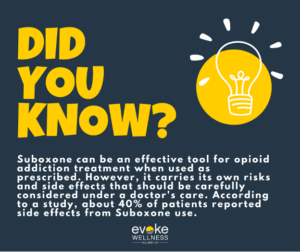You’ve likely heard of Suboxone, the popular medication used to treat opioid dependence. But how much do you really know about this drug that’s become a lifeline for so many? In this article, we’ll give you the full rundown on Suboxone – from how it works to its potential side effects. With opioid overdose deaths still tragically high, understanding medications like Suboxone is more critical than ever. We’ll provide details on the various treatment programs Suboxone is used in, from outpatient treatment to residential settings. And we’ll share statistics that illuminate the scope of the opioid epidemic and Suboxone’s role within it.
If you or a loved one is considering treatment, Evoke Wellness at Hilliard invites you to contact us. Our compassionate team is ready to answer your questions, discuss your needs, and help you take the first steps toward recovery. In Hilliard, you’ll find more than just a treatment program – you’ll discover a community dedicated to your wellness and success. Together, let’s embrace the journey to recovery and the promise of a new beginning. Call us at (833) 949-1347 today or reach out online.
What Is Suboxone?
A Potent Opioid Treatment
Suboxone is a prescription medication used to treat opioid addiction and dependence. It contains two active ingredients – buprenorphine and naloxone. Buprenorphine is a partial opioid agonist that helps reduce cravings and withdrawal symptoms. Naloxone is an opioid antagonist that reverses and blocks the effects of opioids.
Combination Therapy
This unique combination allows Suboxone to:
- Suppress withdrawal symptoms during detox
- Reduce cravings for opioids
- Block the euphoric effects of opioids if misused
Research shows Suboxone is effective, with around 49% of patients remaining in treatment after one year.
Comprehensive Treatment
However, Suboxone works best when combined with counseling and behavioral therapies as part of a comprehensive treatment program. This helps address the root causes of addiction for long-term recovery.
How Does Suboxone Work?
Blocking Opioid Receptors
Suboxone contains two key ingredients – buprenorphine and naloxone. Buprenorphine is a partial opioid agonist that attaches to the same brain receptors targeted by drugs like heroin and prescription painkillers.
However, buprenorphine only partially activates these receptors, producing a “ceiling effect” that prevents the intense high associated with full opioid agonists. This reduces cravings and withdrawal symptoms without causing euphoria.
Deterring Abuse
The naloxone component is an opioid antagonist that blocks opioid receptors. It is included to discourage abuse by injection, as naloxone can trigger withdrawal if Suboxone is misused this way.
When taken as prescribed under the tongue, naloxone has minimal effects. But if injected, it neutralizes the effects of buprenorphine and any other opioids in the system.
Safe, Controlled Relief
By occupying opioid receptors with a partial agonist like buprenorphine, Suboxone allows patients to discontinue opioid abuse without suffering severe withdrawal symptoms. Its ceiling effect provides controlled relief while preventing the cycle of addiction and misuse.
This unique dual mechanism makes Suboxone an effective medication for opioid addiction treatment when used as part of a comprehensive program.
Uses of Suboxone for Opioid Addiction
Medication-Assisted Treatment
Suboxone is a powerful medication used to treat opioid addiction. It contains buprenorphine and naloxone, helping to reduce cravings and withdrawal symptoms while blocking the effects of opioids.
Comprehensive Care
For you to recover successfully, Suboxone should be part of a comprehensive treatment program that also includes counseling and behavioral therapies. This holistic approach addresses the root causes of addiction.
Long-Term Solution
While not a cure, Suboxone can be taken for months or years to prevent relapse and increase your chances of achieving long-term sobriety from opioid dependence. With proper treatment and support, you can reclaim your life.
Side Effects and Safety Concerns of Suboxone
Common Side Effects
- Headaches, dizziness or drowsiness
- Nausea, vomiting or constipation
- Sweating or flushing
Serious Risks
- Respiratory depression (shallow breathing)
- Severe allergic reactions
- Dependency and potential for abuse
Usage Precautions
You should never mix Suboxone with alcohol, benzodiazepines or other opioids/narcotics. Doing so increases the risk of overdose and life-threatening side effects. Suboxone requires medical supervision to ensure proper dosing and minimize withdrawal symptoms during the taper process.

Suboxone Treatment Programs and Detox
Whether you or a loved one struggles with opioid dependence, or you’re simply curious to learn more, read on for the unfiltered truth about this complex yet promising treatment option.
- Suboxone Treatment Program
- Drug Detox center
- Residential Treatment program
- Intensive inpatient treatment program
- Rehab aftercare program
- Veterans Program
- Drug addiction treatment program
Struggling with opioid addiction? You’re not alone. Our comprehensive suboxone treatment programs provide a safe, medically-supervised path to recovery.
Personalized Detox Plans
The first step is detox. Our caring team creates a personalized plan to minimize withdrawal symptoms and cravings as opioids leave your system. Suboxone helps make this transition smoother.
Residential Treatment
After detox, continue your journey in our residential program. Live on-site and participate in counseling, group therapy, life skills classes and more – all designed to address every aspect of addiction.
Outpatient Options
Can’t take time away for inpatient care? We offer flexible outpatient programs that allow you to live at home while receiving treatment and support. It’s recovery on your terms.
Ongoing Support
Recovery is a lifelong process. Our aftercare program provides access to peer support groups, sober living resources, and alumni programs to help you maintain sobriety long-term.
No matter which path you choose, our evidence-based suboxone treatment gives you the tools to break free from opioid dependence and rebuild the life you deserve. Reach out today.
Suboxone vs Other Medications for Opioid Addiction
Unlike traditional opioid treatments that fully block receptors, Suboxone partially activates them to ease withdrawal symptoms and cravings. This “partial agonist” approach makes Suboxone harder to abuse.
Other Medication Options
- Methadone – A full opioid agonist that prevents withdrawal but carries a high risk of abuse and overdose.
- Naltrexone – An opioid antagonist that fully blocks receptors but requires complete detox first.
Advantages of Suboxone
- Convenient once-daily dosing under the tongue.
- Lower risk of abuse and overdose than methadone.
- Can be prescribed in an outpatient setting.
- Ceiling effect limits respiratory depression at high doses.
With over 16 million Americans suffering from opioid addiction, medications like Suboxone offer an important treatment pathway. Discuss all options with an addiction specialist to find the right fit.
FAQ on Suboxone
What is Suboxone?
- Suboxone contains buprenorphine and naloxone to treat opioid use disorder.
- It helps reduce opioid cravings and withdrawal symptoms.
How does it work?
- Buprenorphine is a partial opioid agonist that binds to the same receptors as drugs like heroin and oxycodone.
- Naloxone blocks the euphoric effects of opioids to deter abuse.
How effective is Suboxone?
- Studies show Suboxone cuts the risk of relapse by 50% compared to placebo.
- In clinical trials, 40-60% of patients achieved sustained recovery.
Are there side effects?
- Common side effects include headache, nausea, sweating, and insomnia.
- Long-term use can cause dependence requiring medically-supervised tapering.
How is it administered?
- Suboxone comes as sublingual films or tablets placed under the tongue.
- Dosing is tailored to each patient based on their needs and history.
Conclusion
You now have a better understanding of the uses, risks, and realities of suboxone treatment. With over 5 million suboxone prescriptions filled each year for opioid addiction, it’s clear this medication can be life-changing when used properly. But it’s not a magic bullet. For suboxone to work long-term, it should be part of a comprehensive treatment plan that addresses the root causes of addiction. With the right mix of counseling, healthy routines, and social support, suboxone can be an empowering aid. But you must take an active role in your recovery. Don’t view suboxone as a cure-all; see it as one tool among many to build the life you deserve. There are always alternatives. With hope, hard work, and the right help, you can overcome opioid addiction and thrive.
Begin Your Journey with Evoke Wellness at Hilliard
If you or a loved one is considering treatment, Evoke Wellness at Hilliard invites you to contact us. Our compassionate team is ready to answer your questions, discuss your needs, and help you take the first steps toward recovery. In Hilliard, you’ll find more than just a treatment program – you’ll discover a community dedicated to your wellness and success. Together, let’s embrace the journey to recovery and the promise of a new beginning. Call us at (833) 949-1347 today or reach out online.



